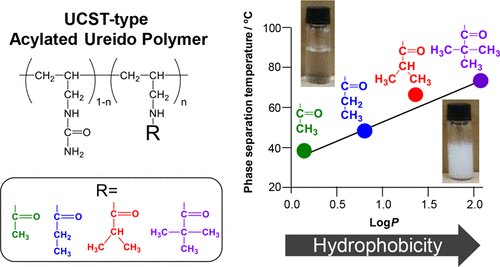当前位置:
X-MOL 学术
›
Biomacromolecules
›
论文详情
Our official English website, www.x-mol.net, welcomes your feedback! (Note: you will need to create a separate account there.)
Rational Design of UCST-type Ureido Copolymers Based on a Hydrophobic Parameter
Biomacromolecules ( IF 6.2 ) Pub Date : 2018-09-05 00:00:00 , DOI: 10.1021/acs.biomac.8b01152 Naohiko Shimada 1 , Taira Sasaki 1 , Takakuni Kawano 1 , Atsushi Maruyama 1
Biomacromolecules ( IF 6.2 ) Pub Date : 2018-09-05 00:00:00 , DOI: 10.1021/acs.biomac.8b01152 Naohiko Shimada 1 , Taira Sasaki 1 , Takakuni Kawano 1 , Atsushi Maruyama 1
Affiliation

|
Thermoresponsive polymers exhibiting upper critical solution temperature (UCST)-type behavior under physiologically relevant conditions have potential as biomaterials. The phase separation temperature (Tp) of the UCST-type polymers can be increased by copolymerization with hydrophobic comonomers. Quantitative index parameters that could be used to rationally tune the Tp are lacking, however. We have reported that ureido copolymers such as poly(allylamine-co-allylurea) (AM-PU) and poly(l-ornithine-co-citrulline) exhibit UCST-type solution behavior under physiologically relevant conditions. In this study, AM-PU was hydrophobized by acylation. Tp of AM-PU can be regulated in a wide temperature range from about 20 to 80 °C or even higher by 20 mol % acylation with acetyl, propionyl, isobutanoyl, or pivaloyl groups, implying considerable impacts of hydrophobic groups on UCST phase separation. We observed a liner relationship between Tp and the hydrophobic parameter, log P, of the acyl groups. Furthermore, the acylation significantly reduced the influence of serum components on Tp by eliminating interactions of copolymers with serum components such as proteins and lipids. Acylation also abolished pH dependence of Tp which had been observed for unmodified AM-PU. Owing to the simple relationship between log P and Tp and the inertness of the acylated copolymer to serum components and pH changes, it is possible to rationally design copolymers exhibiting UCST-type behavior at a desired temperature under biological conditions.
中文翻译:

基于疏水参数的UCST型脲醛共聚物的合理设计
在生理相关条件下表现出较高临界溶液温度(UCST)型行为的热敏聚合物具有作为生物材料的潜力。UCST型聚合物的相分离温度(T p)可通过与疏水性共聚单体共聚而提高。但是,缺少可用于合理调节T p的定量指标参数。我们已经报道了脲基共聚物,例如聚(烯丙胺-共-烯丙基脲)(AM-PU)和聚(1-鸟氨酸-共-瓜氨酸)在生理相关条件下表现出UCST型溶液行为。在这项研究中,AM-PU被酰化疏水化。Ť p通过在乙酰基,丙酰基,异丁酰基或新戊酰基上进行20 mol%的酰化,可以在约20至80°C或什至更高的温度范围内调节AM-PU的官能度,这意味着疏水基团对UCST相分离有很大影响。我们观察之间的线性关系Ť p和疏水性参数,请登录P,酰基的。此外,酰化通过消除共聚物与诸如蛋白质和脂质的血清成分的相互作用而显着降低了血清成分对T p的影响。酰化作用还消除了未经修饰的AM-PU所观察到的T p的pH依赖性。由于log P与T p和酰化共聚物对血清组分和pH值变化的惰性,可以合理地设计在生物学条件下在所需温度下表现出UCST型行为的共聚物。
更新日期:2018-09-05
中文翻译:

基于疏水参数的UCST型脲醛共聚物的合理设计
在生理相关条件下表现出较高临界溶液温度(UCST)型行为的热敏聚合物具有作为生物材料的潜力。UCST型聚合物的相分离温度(T p)可通过与疏水性共聚单体共聚而提高。但是,缺少可用于合理调节T p的定量指标参数。我们已经报道了脲基共聚物,例如聚(烯丙胺-共-烯丙基脲)(AM-PU)和聚(1-鸟氨酸-共-瓜氨酸)在生理相关条件下表现出UCST型溶液行为。在这项研究中,AM-PU被酰化疏水化。Ť p通过在乙酰基,丙酰基,异丁酰基或新戊酰基上进行20 mol%的酰化,可以在约20至80°C或什至更高的温度范围内调节AM-PU的官能度,这意味着疏水基团对UCST相分离有很大影响。我们观察之间的线性关系Ť p和疏水性参数,请登录P,酰基的。此外,酰化通过消除共聚物与诸如蛋白质和脂质的血清成分的相互作用而显着降低了血清成分对T p的影响。酰化作用还消除了未经修饰的AM-PU所观察到的T p的pH依赖性。由于log P与T p和酰化共聚物对血清组分和pH值变化的惰性,可以合理地设计在生物学条件下在所需温度下表现出UCST型行为的共聚物。



























 京公网安备 11010802027423号
京公网安备 11010802027423号